Physical Address
304 North Cardinal St.
Dorchester Center, MA 02124
Three basic mechanisms cause soft tissue injuries: blunt trauma, crushing injury, and penetrating trauma. Blunt and crushing injuries are called closed injuries because they do not penetrate the overlying skin. Penetrating (open) injuries violate the protective skin layer, contaminating the wound and thus producing open injuries.
Closed injuries are characterized by variable degrees of damage to skin and underlying soft tissue and are an inevitable component of any fracture (see Plate 7-1 ). Blood vessels are most vulnerable to injury; thus, closed soft tissue injuries usually produce bleeding and swelling beneath the skin. The pathophysiologic process of a soft tissue injury can be broken down into three phases: inflammatory, proliferative, and reparative. The initial trauma injures the blood vessels, causing local bleeding, disruption of the microcirculation, and exposure of subendothelial collagen, which triggers the cellular inflammatory and clotting pathways. Inflammatory mediators increase capillary permeability, leading to edema, further local impairment of perfusion, and local tissue hypoxia and acidosis. Chemotactic factors also attract immune cells; mainly neutrophils and macrophages in the acute stage—neutrophils to defend against bacteria and macrophages for debridement of necrotic tissue. This phase reaches a maximum intensity at 1 to 3 days after the injury. The second, or proliferative, phase involves fibroblast production of extracellular matrix proteins and revascularization via endothelial ingrowth. The third, or reparative, phase involves scarring and fibrosis. Bleeding results from disruption of the blood vessels, and swelling results from damage to the endothelial lining of the blood vessels, which allows plasma to leak into the soft tissue spaces.
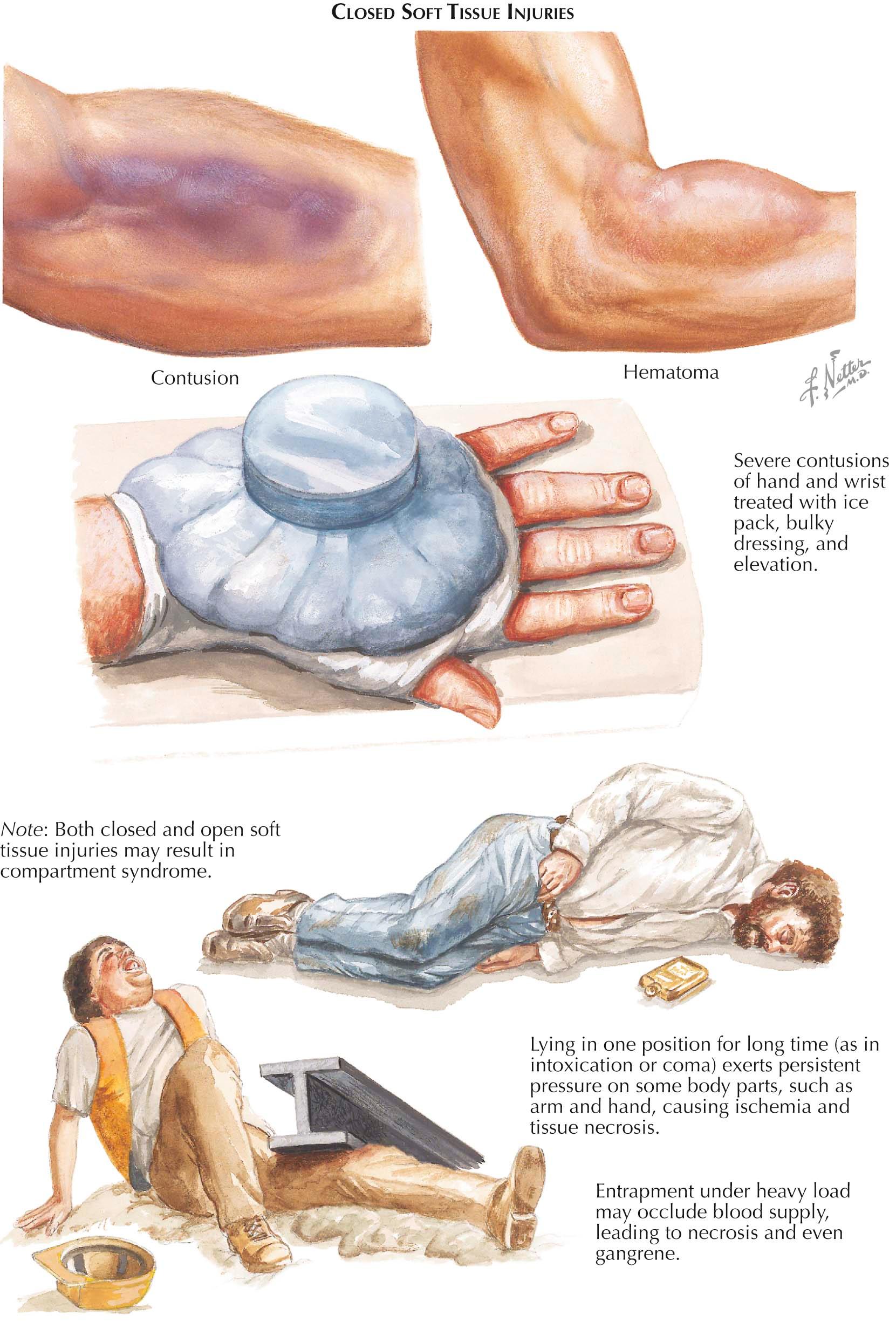
The most common soft tissue injury is a contusion (bruise) caused by blunt trauma that damages blood vessels and results in bleeding or swelling into the soft tissues. Usually the blood and the edema fluid dissect between the cells of the soft tissues, causing localized swelling. Bleeding produces the typical black-and-blue discoloration of a contusion. If large vessels are disrupted, the pressure of the escaping blood can induce separation of the tissue planes, leading to the accumulation of a large hematoma beneath the skin or between the deeper layers of soft tissue.
Contusion and hematoma formation may accompany more serious injuries of the limbs, such as fractures, dislocations, and sprains. The clinical examination of a patient with a painful contusion must rule out more serious underlying problems. A simple contusion or hematoma is treated with the immediate application of ice, a gentle compression dressing, and elevation of the injured part. Temporary restriction of activity—voluntary or with the application of a compression dressing or splint—facilitates the body's ability to repair a soft tissue injury. The simple mnemonic ICES (Ice, Compression, Elevation, and Splinting) can be used to remember the principles of treatment. Because soft tissue injuries rarely cause significant disruption of important soft tissue structures, the body reabsorbs the extravasated blood and edema fluid within a few days, allowing gradual return of function. A large hematoma may take several weeks to resolve, however.
Soft tissue injuries associated with fractures (closed) can be described according to the classification system of Oestern and Tscherne, which grades soft tissue injuries from 0 to 3:
Grade 0: minimal soft tissue damage usually from an indirect injury to the limb and typically associated with a simple underlying fracture pattern
Grade 1: superficial abrasions or contusions typically associated with a mild underlying fracture pattern
Grade 2: deep abrasions with skin or muscle contusion usually from direct trauma to the limb and typically with a severe underlying fracture pattern
Grade 3: extensive skin contusion or crush, severe damage to underlying muscle, subcutaneous avulsion, and compartment syndrome and typically seen with a severe fracture pattern
This grading system is often used to guide timing and surgical planning when operative fixation is needed. It has also been shown to be predictive of the time to return to function.
An internal degloving injury is a unique type of soft tissue injury that may be seen with or without fracture. It results from significant shear forces causing the separation of subcutaneous tissues from underlying fascial or osseous structures with a resultant collection of liquefied fat, blood, and necrotic tissue. It is most commonly seen over the greater trochanter, where it is referred to as a Morel-Lavallée lesion, but can be seen in the flank or lumbodorsal regions as well. These injuries can compromise the overlying skin and soft tissue if not addressed surgically and present a risk for infection and a challenge in planning for operative fixation of underlying fractures.
Soft tissues can also be damaged by the continuous application of force over relatively long periods of time (hours or days). This mechanism of injury, called a crushing injury, causes damage by direct force and also by impairment of circulation to the tissues. Continuous pressure that is in excess of the capillary filling pressure causes the compressed soft tissue to become ischemic and die.
Crushing injury takes many forms. One of the most vulnerable soft tissues is the skin; continuous pressure applied for more than 2 hours can result in ischemia and the development of a pressure ulcer. Pressure ulcers are particularly likely to develop in skin that overlies a bony prominence and is compressed against a firm surface such as a cast, a rigid shoe or brace, or even a firm mattress. Although the initial lesion is closed, when the skin dies, it sloughs and the lesion may become infected.
Another type of crushing injury occurs when a heavy load falls on a limb, rendering it immobile and obstructing the blood flow (venous, arterial, or both) for several hours. The result is a compartment syndrome. If the resulting ischemia lasts for more than 2 hours, it may cause the death of muscle tissue, with associated permanent loss of function. When blood flow is restored to a crushed limb, the necrotic muscle releases myoglobin into the venous circulation. The myoglobin may sludge in the kidneys, producing acute renal failure. The risk of this complication may be minimized by adequate hydration of the patient after a crush injury. Ischemia that persists for a long time leads to gangrene of the entire crushed limb.
Open soft tissue injuries are, by definition, contaminated (see Plate 7-2 ). The many different types of open soft tissue injuries—abrasion, laceration, avulsion, puncture, degloving, and amputation—are caused by a variety of mechanisms. Regardless of the particular pattern of injury, the common denominators are penetration of the skin and bacterial contamination of the deeper tissues, which establish the potential for infection. Blood loss in open wounds is usually greater than in closed injuries, because the bleeding is not limited by the tamponade effect created by the encompassing soft tissues.
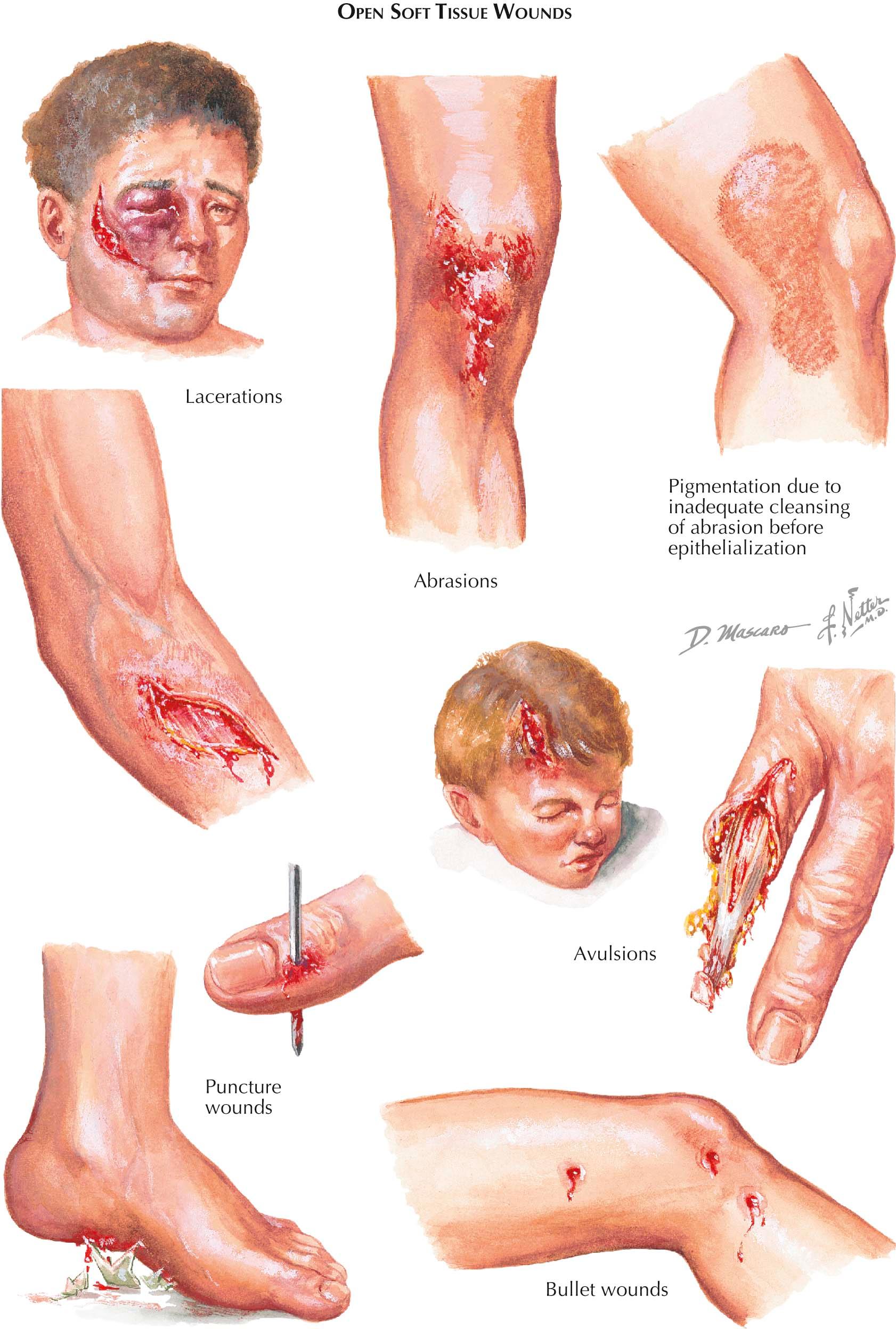
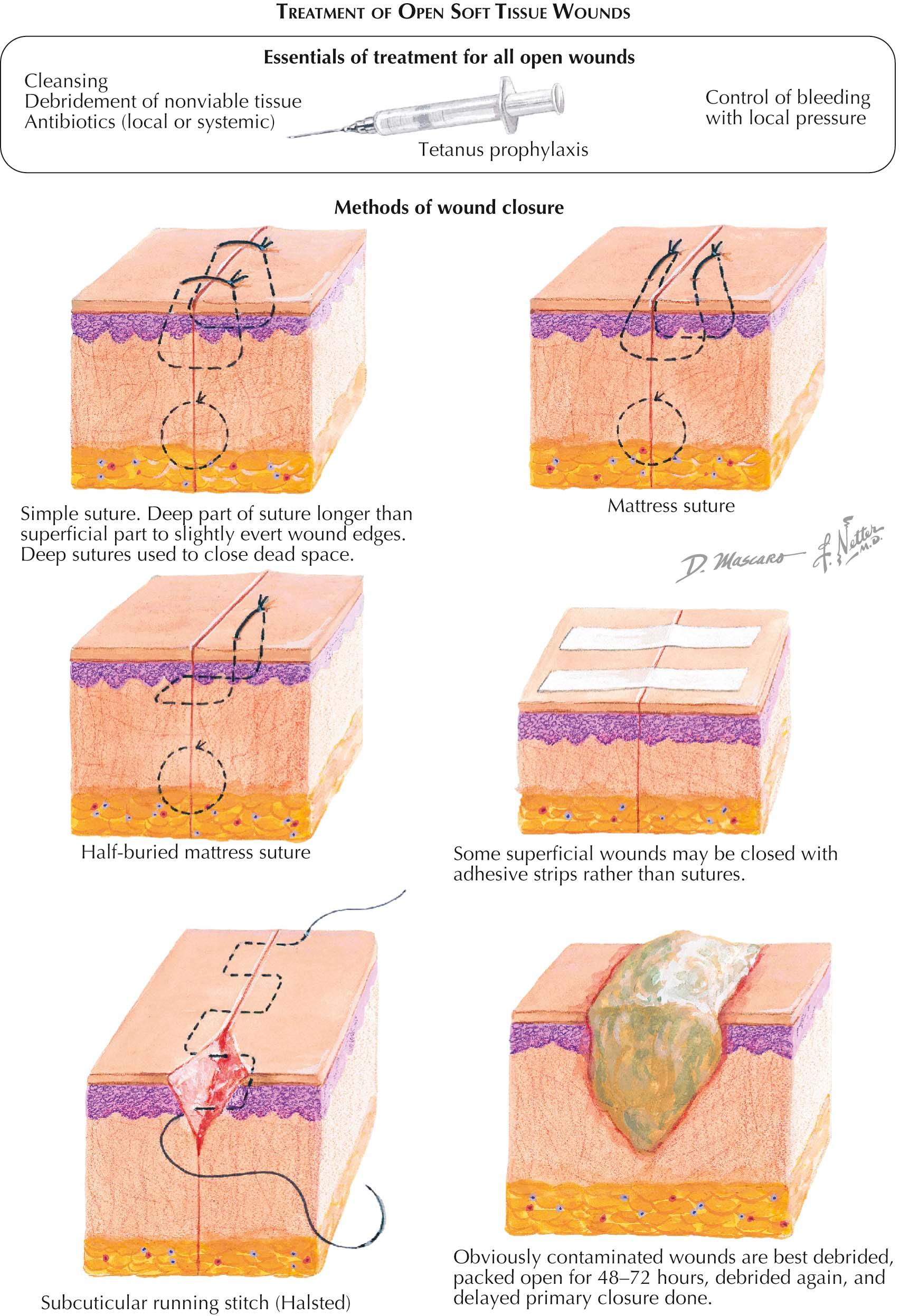
Treatment of open wounds initially focuses on controlling the bleeding and contamination. Pressure should be applied to the wound at once to stop bleeding, and tetanus prophylaxis must be confirmed or provided and in certain situations (e.g., open fracture) antibiotics should be administered. After the bleeding is controlled, all open wounds must be thoroughly debrided to remove as much contaminating material and nonviable tissue as possible. Whenever the adequacy of the initial debridement is in doubt, wound closure should be delayed until the surgeon is confident that no deep contaminants persist and there is no sign of active wound infection. In patients with severe contamination, or open fractures, antibiotics can be used to help control the onset of infection but should never be used as a substitute for surgical debridement. If needed, serial debridements should be performed at 48- to 72-hour intervals until the surgeon is satisfied that all contaminated and necrotic or nonviable tissues have been removed. Often in the case of open fractures or other high-energy injuries it is not possible to determine the full extent of soft tissue injury at the index debridement. Once adequate debridement has taken place, delayed primary closure can be attempted.
Not all wounds are amendable to primary closure, even on a delayed basis. Advancements in wound care technology have afforded new ways to achieve closure of a wound, decrease the need for flap coverage, and improve survival of split-thickness skin grafts. The most significant advancement is that of “vacuum-assisted wound closure,” or the wound VAC. The wound VAC is a closed, negative-pressure system for healing wounds. After a wound has been adequately debrided a reticulated polyurethane sponge is trimmed to fit the wound so that it is in direct contact with all wound surfaces and either packed into or placed on top of the wound. This is then covered with a clear adherent flexible plastic dressing through which passes a plastic tube that attaches to a suction/reservoir device. The VAC is typically changed roughly every 48 hours either at bedside or in the operating room if sedation is required. The pump is typically run at a continuous −125 mm Hg because this has shown to produce the peak improvement in blood flow without the pain from intermittent pressure with wound contraction/expansion.
The negative pressure system removes interstitial edema fluid that grossly decreases swelling. On a microcirculatory level, it decreases capillary afterload, improving local blood flow and oxygen delivery. The mechanical stress created from the negative pressure and resultant contraction of the “dead space” of the wound may stimulate angiogenesis. Granulation tissue formation and wound contracture are stimulated. Because it is a closed system there is less risk of bacterial contamination, especially for those patients in intensive care unit settings or with wounds in moist or frequently contaminated areas. The wound VAC has shown to be beneficial when applied over the recipient site of a split-thickness skin graft with increased ingrowth rates for which the sponge is applied on top of the graft (sometimes with a petrolatum gauze layer in between to prevent adhesion and liftoff with sponge changes). The VAC has shown promise in helping with persistently draining surgical wounds when applied over the draining incision for a brief period to help decrease local swelling.
With the exception of certain nerve injuries, all soft tissues heal by the formation of collagenous scar tissue. Prompt, careful, and anatomic reapproximation of injured tendon, muscle, and skin provides the best basis for a functional and satisfactory result. Failure to achieve repair of an injured tendon often results in significant functional loss.
Effective repair of a lacerated tendon remains a great surgical challenge because tendons often heal with an excess of scar tissue and loss of their natural gliding function. The principles of tendon repair therefore include thorough debridement of the wound, precise anatomic reapproximation, and protected active range of motion during healing to help maintain the mobility essential for normal function. The range of motion allowed after repair is limited by the particular tendon injured, the location of the laceration along the course of the tendon, and the strength of the surgical repair.
Peripheral nerve injury was described by Seddon as either neurapraxia, axonotmesis, or neurotmesis and later further subdivided by Sunderland. Neurapraxia (Sunderland 1) involves local damage to myelin, often from compression or stretch associated with an injury. There is no disruption in axon continuity, and no distal degeneration takes place so no permanent loss of function is expected; recovery typically takes weeks to months. Axonotmesis involves loss of continuity with varying damage to surrounding connective tissue. Sunderland subdivided this with type 2, retaining intact endoneurium, perineurium, and epineurium, which helps guide healing axons and prevents infrafascicular healing so complete functional recovery may take place, but on the order of months. Sunderland type 3 involves disruption of the endoneurium, and recovery is often incomplete. In Sunderland type 4, the perineurium is disrupted as well, leaving only epineurium, and may require excision and surgical repair of the damaged segment. Neurotmesis, equivalent to Sunderland type 5 injuries, involves complete disruption of the nerve. Laceration of a peripheral nerve disrupts the axons that normally carry impulses to and from the central nervous system, and restoration of nerve function depends on the effective repair of these axons. The distal segment undergoes wallerian degeneration, leaving the basal lamina of the Schwann cells to serve as guiding structures for the growth cone at the tip of the regenerating axon to it is hoped grow through. Complete nerve lacerations should be referred for surgical evaluation to an orthopaedic or plastic surgeon trained in microsurgical nerve repair. The principles of peripheral nerve repair include adequate debridement, careful anatomic repair by means of group fascicular repair, and/or simply epineurial repair (controversy still exists between the two). When primary repair cannot be achieved without tension, autografts, allografts, and entubulation chambers are therapeutic options being investigated. Failure to achieve satisfactory repair of a lacerated peripheral nerve results in permanent loss of its function and often produces a painful neuroma at the injury site.
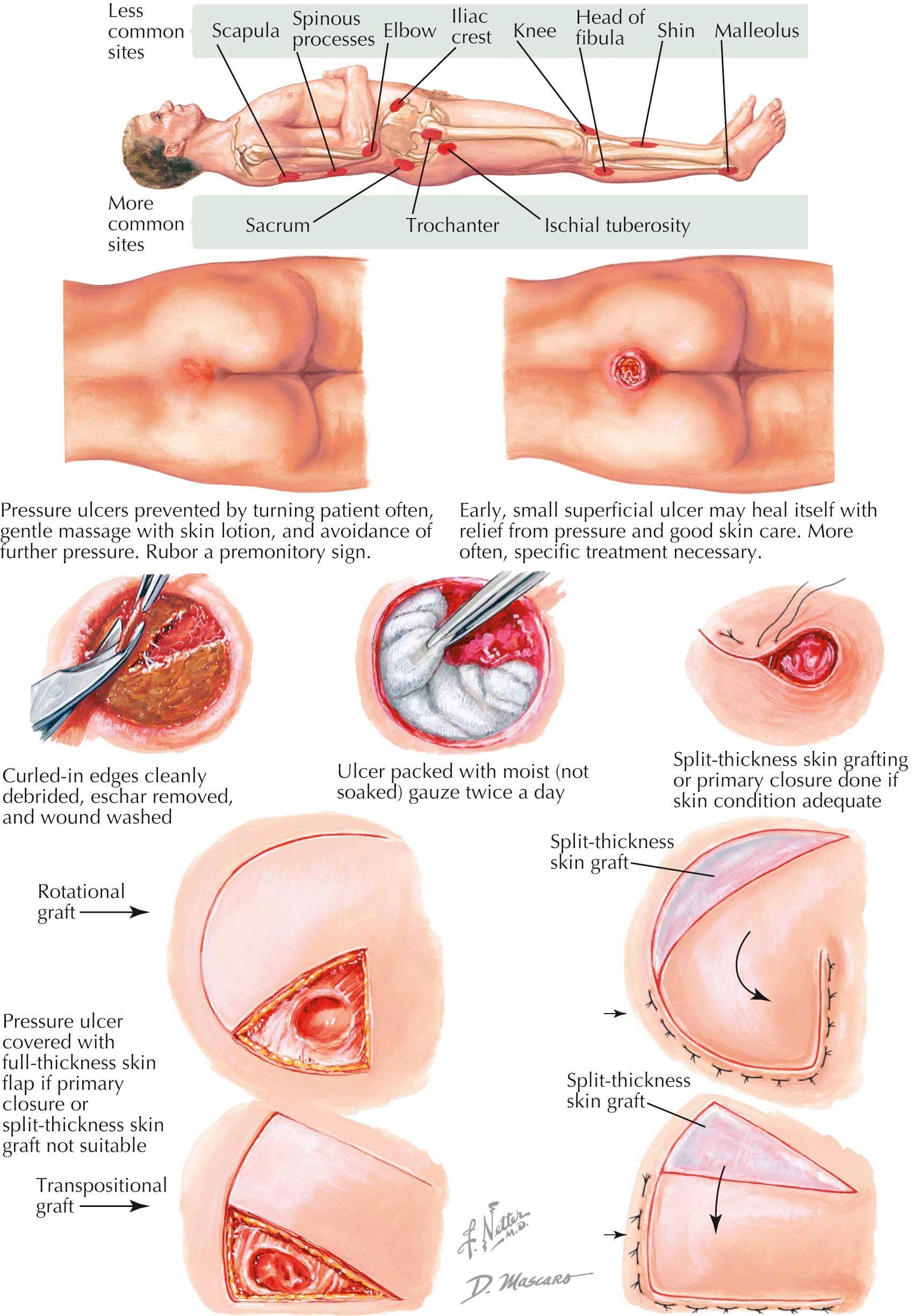
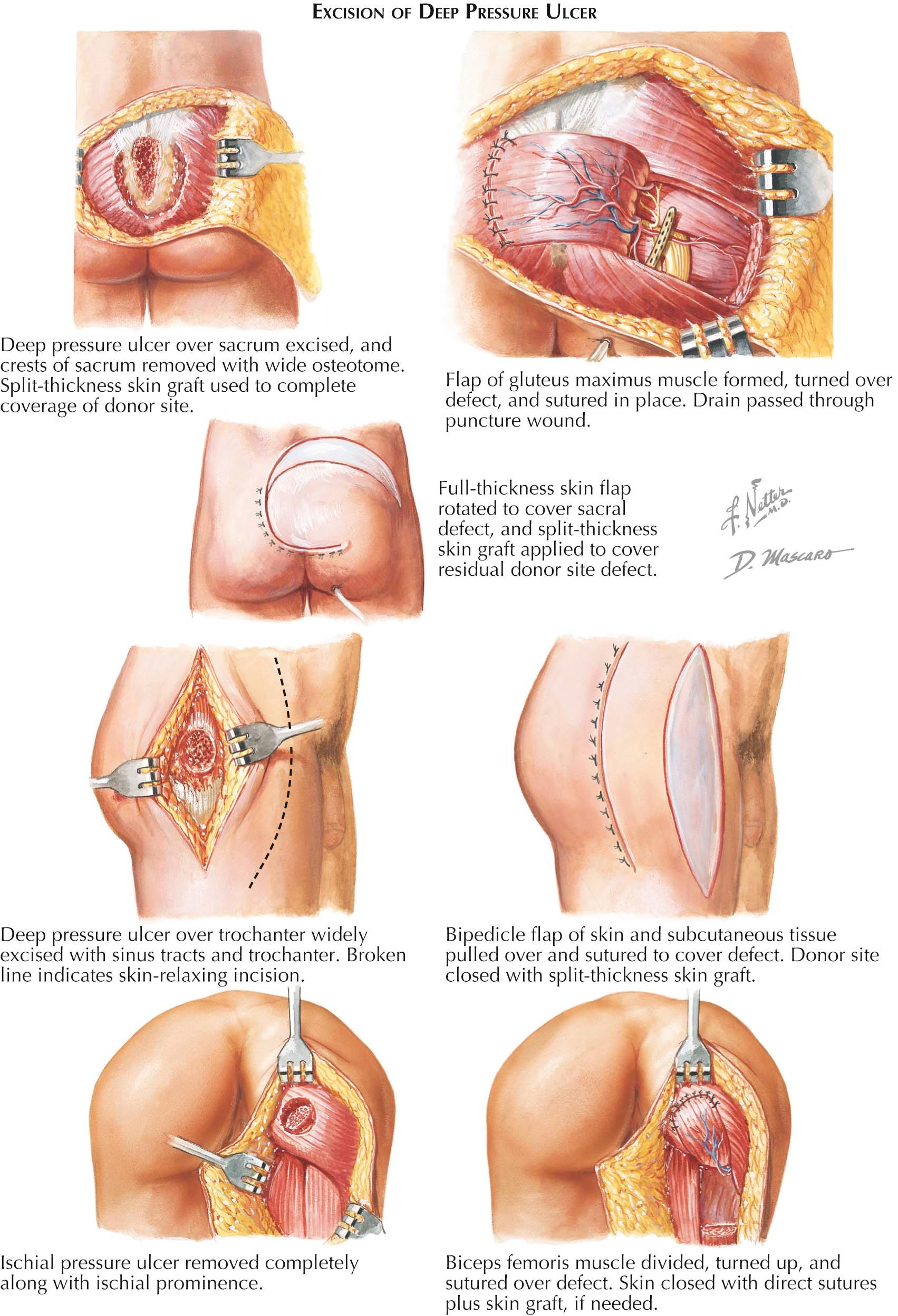
Pressure ulcers are localized areas of necrosis involving skin and/or deeper tissues usually occurring over a bony prominence (see Plate 7-4 ). They develop when the soft tissue is compressed between the body and a rigid or firm surface and are common complications of immobilization. Elderly patients are particularly at risk, and in patients older than 70 years of age, pressure ulcers increase the risk of death up to four times. Pressure ulcers, formerly called decubitus ulcers and bedsores, can occur anywhere, but the most common sites are over the sacrum, coccyx, greater trochanter, ischial tuberosity, and heels. Pressure ulcers are caused by a combination of pressure and shear forces. Pressure is described as force directed perpendicular to the surface, and shear is force directed parallel to the surface. Pressure forces compress the vessels that run parallel to the surface of the skin, and shear forces cause bending and occlusion of those perpendicular to the skin. Studies have shown that pressure in excess of approximately 32 mm Hg will occlude dermal vessels, resulting in local ischemia, interstitial fluid, pain, and necrosis of tissue, and that this may start after as little as 2 hours at such levels. The deeper tissues such as muscle are more sensitive to pressure, and as such the damage may spread over a greater area the deeper it goes. Damage may also be done to soft tissue by friction forces, such as those seen on the skin from sliding or moving patients across bed linens. This causes abrasions and epidermal damage that further decrease the tissue's tolerance to insult from pressure. Necrotic tissue is highly susceptible to bacterial infection, which contributes to further necrosis and destruction of both soft tissue and bone.
In 2007, the National Pressure Ulcer Advisory Panel revised its previous staging scale to include Suspected Deep Tissue Injury and Unstageable Ulcers in addition to the previously described Stages I to IV:
Suspected deep tissue injury: purple or maroon localized area of discolored intact skin or blood-filled blister due to damage of underlying soft tissue from pressure and/or shear. The area may be preceded by tissue that is painful, firm, mushy, boggy, and warmer or cooler as compared with adjacent soft tissue.
Stage I: intact skin with nonblanchable redness of a localized area usually over a bony prominence. Darkly pigmented skin may not have visible blanching; its color may differ from the surrounding area.
Stage II: partial-thickness loss of dermis presenting as a shallow open ulcer with a red pink wound bed, without slough; may also present as an intact or open/ruptured serum-filled blister.
Stage III: full-thickness tissue loss. Subcutaneous fat may be visible, but bone, tendon, or muscle is not exposed. Slough may be present but does not obscure the depth of tissue loss; may include undermining and tunneling.
Stage IV: full-thickness tissue loss with exposed bone, tendon, or muscle. Slough or eschar may be present on some parts of the wound bed; often includes undermining and tunneling.
Unstageable: full-thickness tissue loss in which the base of the ulcer is covered by slough (yellow, tan, gray, green, or brown) and/or eschar (tan, brown, or black) in the wound bed. Unstageable ulcers may be restaged after debridement allows determination of the true extent of the wound.
Risk factors for development of a pressure ulcer include neurologic impairment due to decreased muscle tone, loss of muscle bulk, and diminished or absent sensorimotor abilities. Surgical patients are at risk during surgery from prolonged positioning and hypotensive anesthesia and postoperatively from immobility, sedative medications, and casts/splints. Other factors that contribute to the development of pressure ulcers, particularly in elderly patients, are impaired circulation, poor nutrition, and possibly impaired immune response. Maceration of the skin, usually due to incontinence, also significantly increases the risk of ulceration. Bedridden and wheelchair-bound patients are particularly vulnerable to the development of pressure ulcers.
A pressure ulcer requires intensive and costly long-term treatment. Therefore, aggressive intervention programs are essential to prevent or abort their formation, particularly in high-risk patients. The most effective means of prevention is the frequent repositioning of patients who are confined in bed, chair, or wheelchair. Position changes must occur every 2 hours to avoid continues excessive pressure over any single bony prominence. Vulnerable skin areas must be monitored frequently, and pressure on stage 1 lesions must be avoided to prevent further progression. For patients at risk for pressure ulcers, passive (or static) cushioning devices such as supersoft mattresses and wheelchair cushions made of foam, water, gel, or air-filled materials should be used; patients who are severely immobilized require active (or dynamic) pressure-relieving devices such as an alternating pressure, air fluidized, or air suspension mattress. Sedation should be avoided, incontinence controlled, and any nutritional deficiencies corrected in all immobile patients. Several studies have shown aggressive intervention applied by an effective multidisciplinary team can greatly reduce the incidence of pressure ulcers in hospitalized patients.
Treatment of an established pressure ulcer must be aggressive and persistent. Pressure-relieving strategies are essential during the entire course to facilitate healing. The first step in management is to assess the extent, depth, and stage of the lesion. Local treatment of a specific ulcer begins with removing the source of pressure. Second, any necrotic tissue is removed. Debridement of necrotic and infected tissue is accomplished with frequent changes of wet-to-dry dressings or with surgical excision of the infected necrotic tissue followed by the application of wet-to-dry dressings or negative pressure wound therapy (NPWT). The use of topical disinfectants and antibiotics is controversial. Although such medications effectively decrease the local bacterial count, many also have the disadvantage of causing local tissue necrosis of the ulcer bed. Dilute noncytotoxic solutions of povidone-iodine or sodium hypochlorite may help to decrease the bacterial count without causing tissue necrosis.
Once the ulcer is clean and a granulation tissue bed well established, definitive coverage/closure needs to be addressed. Small superficial ulcers heal by secondary intention as long as pressure is kept off the affected area. Larger lesions can be treated surgically with split-thickness skin grafting; occasionally, primary skin closure is accomplished by mobilization of adjacent skin flaps. Large ulcers occasionally require full-thickness coverage with a local full-thickness rotational skin flap and the assistance of a plastic surgeon. At the time of flap rotation the underlying bony prominences may be removed or remodeled to reduce the potential for recurrent pressure ulcers. Negative pressure wound therapy has been a significant advancement in the treatment of pressure ulcer wounds. Negative pressure wound therapy can facilitate fibrinous debridement at dressing changes the way wet-to-dry do and also isolates the wound from contamination while removing edema and local moisture. It also encourages contraction of the wound and may limit the extent of coverage needed. In areas that are particularly vulnerable to recurrence, rotation of a myocutaneous flap to provide greater padding over the bony prominence should be considered.
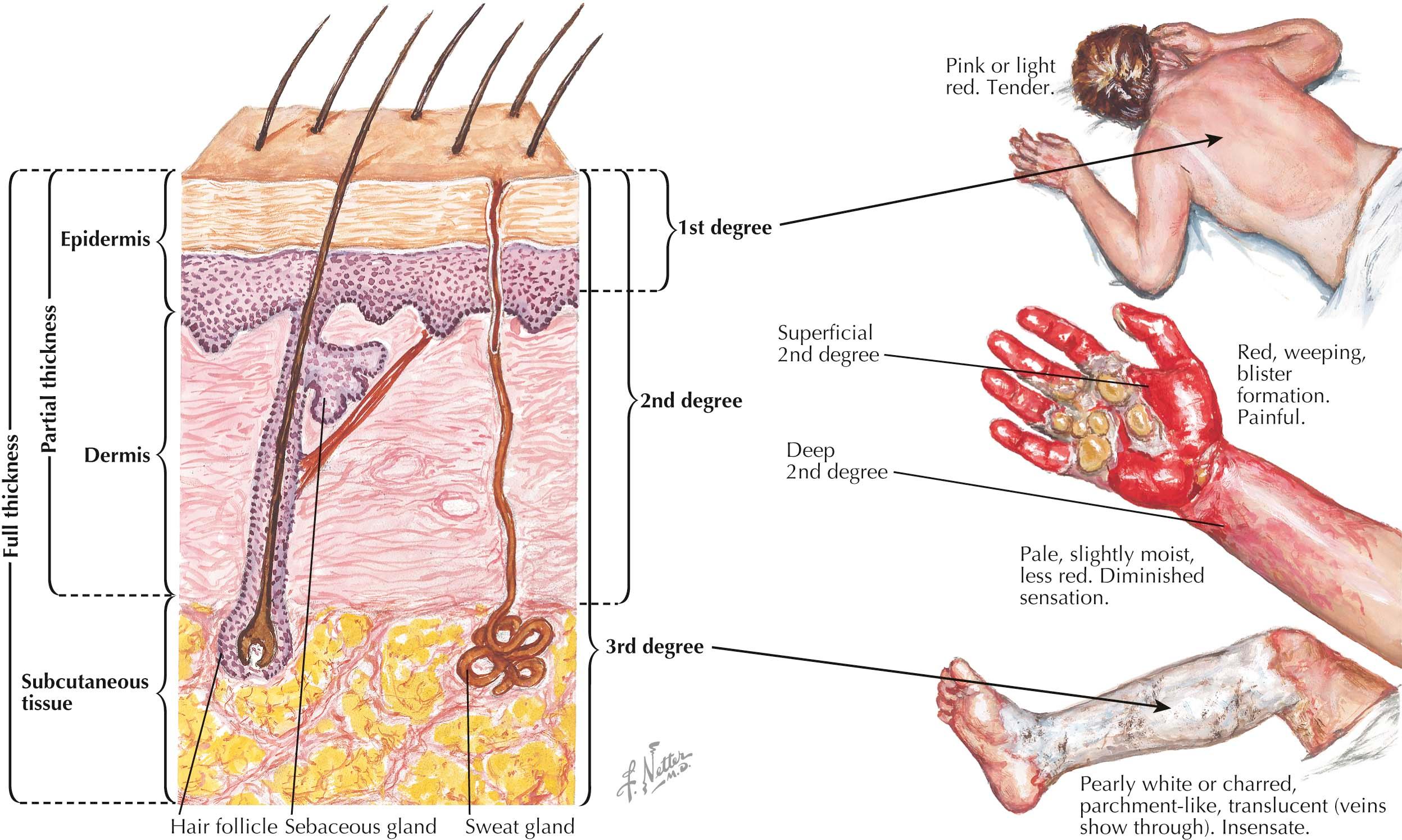
More than 2 million people in the United States are burned every year. The severity of tissue damage is related to both the temperature and the duration of exposure. The local effects of a burn, the wound care required, and the ultimate functional and cosmetic results are determined by the depth of cell injury. The outer layer of the skin, the epidermis, is made up of stratified epithelial cells that arise by proliferation of the basal layer and become progressively keratinized as they are slowly elevated to the surface, where they desquamate (see Plate 7-6 ). The dermis is the inner layer of vascularized and variably dense connective tissue in which arise the skin appendages (hair follicles, sebaceous glands, and sweat glands). Beneath the dermis lies a layer of fatty, loose areolar connective tissue.
Heat of sufficient intensity and duration causes coagulation necrosis and cell death, but the cell damage due to heat of lesser intensity is potentially reversible. The region of immediate cell death caused by a burn is the zone of coagulation. Areas of progressively less damaging cell injury are the zones of stasis, in which the initially compromised blood flow improves with time, and the zone of hyperemia, in which there is marked increase in blood flow as a consequence of burn-induced inflammation. In a full-thickness (third-degree) burn, the zone of coagulation comprises the entire thickness of the dermis. In a partial-thickness (second-degree) burn, a variable portion of the dermis is involved, and in a first-degree burn, only the epidermis is affected.
A first-degree burn is the most superficial form of a partial-thickness burn, sunburn being the most common. The skin is pink or light red; the surface is usually dry, although small blisters may form. The skin remains soft with minimal edema, with subsequent exfoliation of the superficial epidermis. Such injuries are hypersensitive but heal in 3 to 6 days. They require little treatment other than administration of analgesics and oral anti-inflammatory medications to minimize inflammation. Cool showers help lessen postural hypotension and provide some pain relief. At the time of exfoliation, antipruritic treatment may be necessary.
Second-degree burns, also partial-thickness injuries, can be subdivided into superficial second-degree burns, which heal within 21 days, and deep second-degree burns, which take longer to heal. Second-degree burns are caused by limited exposure to a hot liquid, flash, flame, or chemical agent. Superficial second-degree burns appear pink or bright red with profuse serous exudation from the surface and may form blisters between the epidermis and the dermis. These injuries are hyperesthetic—even a draft of air can cause pain. Deep partial-thickness, or second-degree, burns extend to the lower layers of the dermis. The surface of a deep second-degree burn is moist and mottled in various hues of red. Sensation to pinprick is reduced, but pressure sensation remains intact. If protected from infection, these injuries heal spontaneously in 3 to 9 weeks, although often with scarring. When occurring around joints, they may impair function and require excision and grafting.
Third-degree burns result from prolonged exposure to a flame, hot object, or chemical agent or from contact with high-voltage electricity. They involve all layers of the dermis as well as underlying adipose and connective tissue. If deeper structures such as muscle, tendon, ligament, and bone are involved, the injury is considered a deep full-thickness or fourth-degree burn and may involve more extensive reconstruction or amputation. The surface of the burn appears pearly white, charred, translucent, or parchment-like; thrombosed superficial vessels are often visible. In young children, the initial appearance of third-degree burns can be misleading: they are initially dark red, slightly moist, and pliable; then the wound desiccates and becomes unpliable and dark reddish brown. Chemical burns cause injury by coagulation necrosis, which may take 12 to 24 hours for the full extent to be seen. Strong acid burns produce deep gray to brown coloring of the skin, which may be confused with suntan. Exposure to strong alkali may result in soap tissue necrosis. High-voltage electric injury typically causes loss of tissue and dense charring at contact sites. The majority of the injury occurs to deeper structures so the initial wound/burn on the skin may be deceiving. The wound surface of all full-thickness burns is insensate and always requires skin grafting for closure.
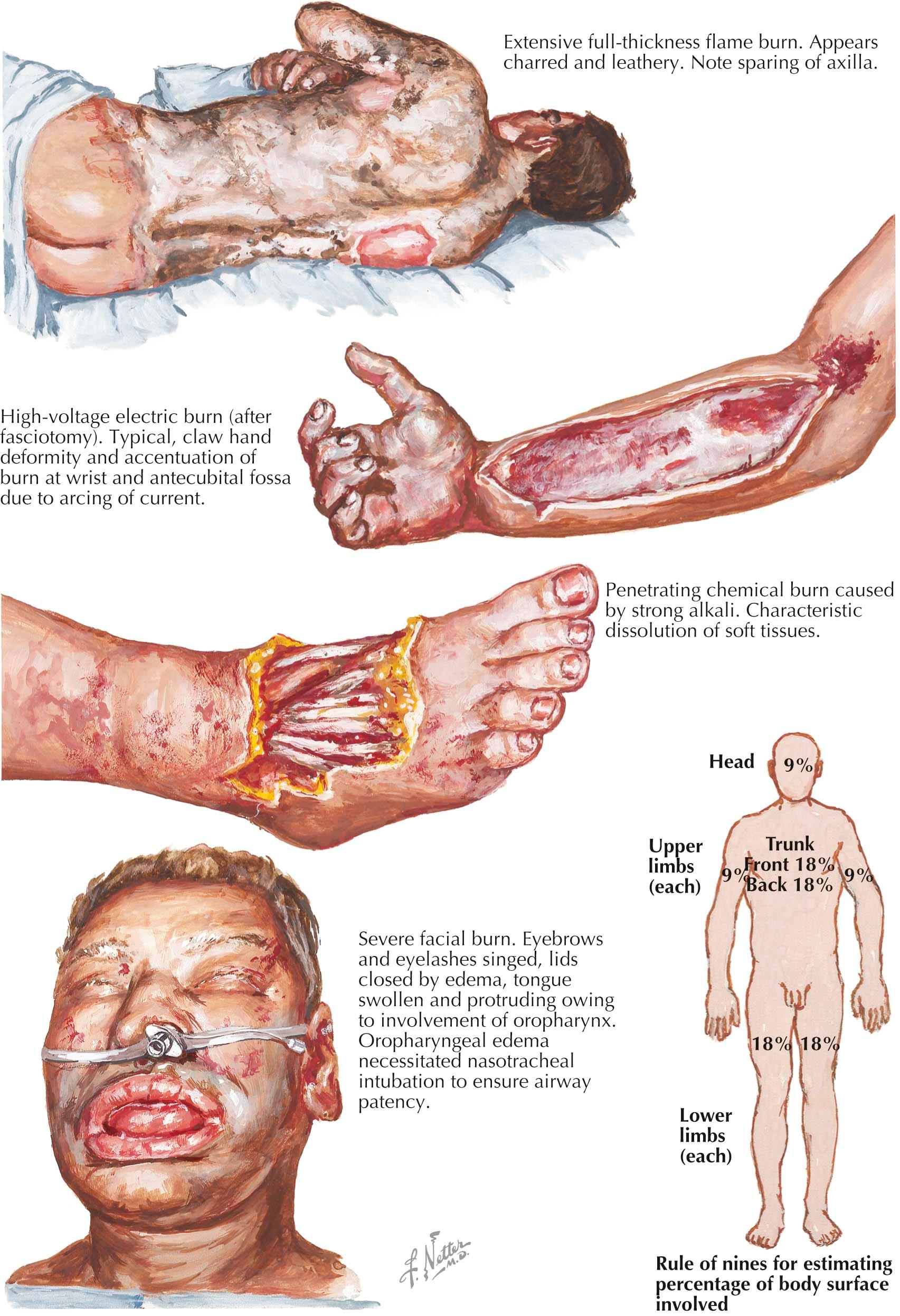
The incidence and causes of burn injury are related to age, occupation, and economic circumstances, with the economically disadvantaged, the elderly, and the very young at greatest risk of both burn injury and death from that injury.
Flame burns are the most common burns in adults. They are usually caused by the mishandling of flammable liquids, ignition of clothing, and house fires and result in an injury of variable thickness: charred, leathery full-thickness burns are intermixed with areas of partial-thickness injury. Sometimes focal areas of uninjured skin in the axilla, groin, antecubital space, and palm are found within the burn. In children younger than 5 years of age, spill scalds are the most common form of injury.
The risk of high-voltage electric injury is greatest in electricians, construction workers, farm workers who move irrigation pipes, oil field workers, truck drivers, and antenna installers. The damage to the tissue is due to heat produced by the resistance of tissue to the passage of electric current. The cell damage is greatest at the site of cutaneous contact but also includes the subcutaneous tissues and organs in the path of the electric current flow. Extensive devitalization of muscle may occur beneath deceivingly small cutaneous lesions. Current arcing also causes severe cutaneous injury at the flexor surfaces of joints, such as the wrist, elbow, and axilla. Claw hand deformity with inability to extend the fingers indicates severe and irreversible damage to the tissues of the hand and forearm and commonly predicts the need for amputation.
Formation of edema beneath the investing fascia of injured tissue may result in impaired blood supply to the distal unburned tissue, necessitating a fasciotomy to reduce the fluid pressure in soft tissue and prevent ischemic necrosis of unburned tissue.
Chemical agents cause exothermic reactions, dehydration, liquefaction necrosis (alkalosis), and delipidation in tissue. The severity of a chemical burn is related to the concentration of the chemical and the amount and duration of contact with tissue. In patients with chemical injury, immediate wound care is the priority, unlike treatment of all other burn patients, in whom systemic support takes precedence. All contaminated clothing should be removed immediately and copious water lavage begun to dilute the chemical agent and reduce the heat in the injured tissue. Strong acids may produce profound tanning of the skin, and strong alkalis penetrate tissue rapidly, causing characteristic liquefaction necrosis of soft tissue.
Formation of edema in the burn area is the result of increased vascular permeability and alterations in the relationships of transvascular pressure. Effects of edema are particularly marked in the loose areolar tissues of the face and oropharynx. The eyelids swell rapidly and may obstruct vision, even though the globe is typically protected by the blink reflex. Swelling of the tongue and other oropharyngeal tissues may compromise the supraglottic airway, necessitating endotracheal intubation to ensure adequate ventilation.
The magnitude and duration of physiologic changes are proportional to the extent of second- and third-degree burns, expressed as a percentage of the body surface. The extent of the burn can be most easily estimated using the rule of nines. In the adult, the surface area of specific anatomic parts represents 9% or a multiple thereof of the total body surface: head and neck, 9%; each upper limb, 9%; each lower limb, 18%; anterior trunk, 18%; posterior trunk, 18%; and genitalia, 1%.
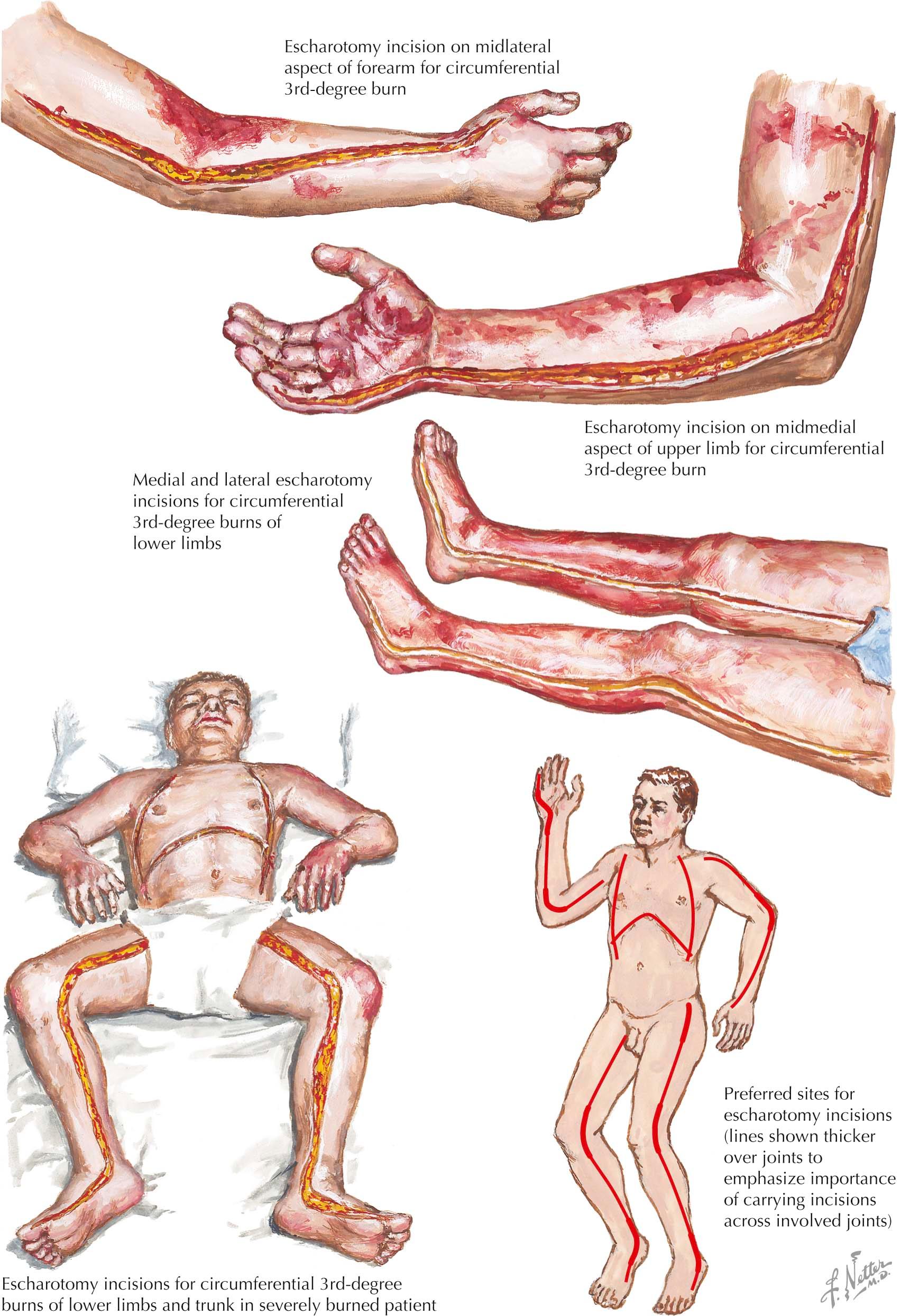
Formation of edema beneath the unyielding leathery eschar of a circumferential third-degree burn on a limb or on the trunk can compromise circulation, ventilation, and nerve/muscle function (see Plate 7-12 ). As the edema increases, tissue pressure rises to exceed venous pressure and approach arteriolar pressure, impairing blood flow to underlying unburned tissues. In the distal unburned tissue, edema and coolness to touch normally accompany thermal injury. Clinical signs of impaired circulation are cyanosis and delayed capillary refilling of distal unburned skin, as well as neurologic change, particularly progressive paresthesias, and unrelenting deep pain. Neurologic change is the most reliable of the clinical signs that predict the need for escharotomy, but an absence of pulsatile blood flow or progressive diminution of flow detected with serial measurements using an ultrasonic flowmeter is a far more reliable indicator. The palmar arch vessels in the upper limb and the posterior tibial vessels in the lower limb are used for assessment. Because hypovolemia and vasoconstriction can attenuate the flowmeter signal, assessment of blood flow should be made only in patients whose hemodynamic stability has been restored with the administration of resuscitation fluid.
Direct measurement of tissue pressure in muscle compartments using a pressure monitor (e.g., Stryker Pressure Monitor introduced in 1988) may also be useful in determining if escharotomy and fasciotomy are needed (see Plate 7-15 ). However, use of invasive pressure monitoring increases the risk of infection of the muscle because the needle must traverse the invariably contaminated burn wound.
Evidence of vascular embarrassment mandates immediate escharotomy, which is performed at bedside using either a scalpel or electrocautery device. Anesthesia is not required because the incisions are made in an insensate third-degree burn. The escharotomy incision is placed in the midmedial or midlateral line of the involved limb and must extend from the distal margin to the proximal margin of the encircling eschar. The incision is carried through the eschar and the immediately adjacent superficial fascia only to the depth necessary to permit the cut edges of the eschar to separate. Bleeding, which is minimal in a properly performed escharotomy, is readily controlled with electrocautery or brief application of external pressure. The escharotomy incisions must be carried across involved joints, where there is the least amount of subcutaneous padding and the vessels and nerves are most easily compressed by the edema-generated pressure.
If a midlateral escharotomy does not restore circulation to a circumferentially burned limb, a second incision is placed in the midmedial line. If the circulation remains impaired after the second escharotomy, fasciotomy must be considered. Rarely, encircling burns of the neck require escharotomy in the line of the anterior margin of the sternocleidomastoid muscle and a circumferentially burned penis may require escharotomy in the middorsal line.
If edema formation beneath an encircling third-degree burn on the truck impairs the ventilatory excursion of the chest wall, mild hypoxia may develop and increased pressure may be needed to ventilate the patient. Bilateral escharotomy incisions extending from the clavicle to the costal margin should be made in the anterior axillary line. If the burn involves a significant portion of the anterior abdominal wall, the anterior axillary incisions should be connected by an incision at the costal margin. All escharotomy incisions must be protected by a generous application of a topical chemotherapeutic agent.
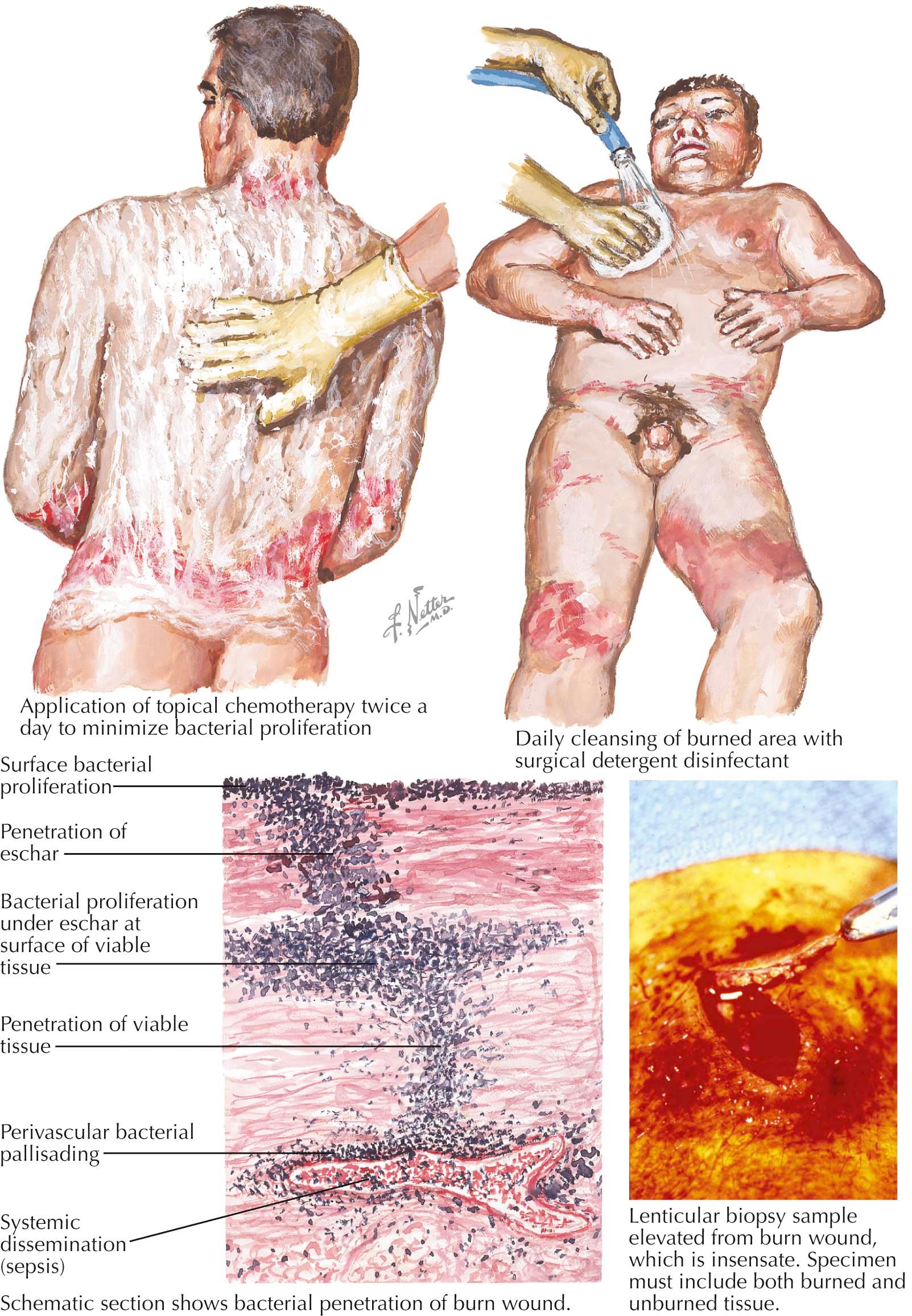
If a burn wound is not protected by topical agents, initially gram-positive flora proliferate and changes and gram-negative microorganisms predominate (see Plate 7-9 ). These organisms penetrate the eschar and multiply in the subeschar space (interface between nonviable and viable tissue). If host resistance is inadequate, the microorganisms penetrate viable tissue. Systemic spread to remote tissues and organs may occur when Pseudomonas organisms invade the microvasculature.
After resuscitation, management focuses on wound care to limit microbial proliferation, which can convert a partial-thickness into a full-thickness burn, and to prevent invasive infection of underlying tissue. Initial care includes gentle cleansing with a surgical detergent disinfectant, debriding nonviable tissue, and shaving hair from the area. A topical agent such as mafenide acetate cream or solution, silver sulfadiazine cream, 0.5% silver nitrate solution, or newer nanocrystalline silver preparations is applied. Silver nitrate solution is bacteriostatic against gram-negative bacteria including some against Pseudomonas, but does not penetrate eschar and has limited antifungal activity. It has the potential to cause electrolyte imbalance because it binds chlorine ions, discolors the wound bed, making visual inspection difficult, and is difficult to apply and maintain, so it is rarely used. Silver sulfadiazine is bactericidal against gram-negative bacilli and sometimes against Pseudomonas with minimal toxicity but does not penetrate eschar. Mafenide acetate (Sulfamylon) (10% cream or 5% solution) has broad gram-negative coverage including Pseudomonas as well as Clostridium species but is ineffective against fungi so concomitant antifungal therapy is needed. The cream is applied to the surface and the wound is left exposed; the solution is applied and soaked in; both formulations penetrate eschar. The solution has been shown to have less pain with application and less inhibition of carbonic anhydrase (leading to metabolic acidosis). Nanocrystalline silver preparations exist in multiple commercial forms; they have broad-spectrum activity, including against Pseudomonas aeruginosa, methicillin-resistant Staphylococcus aureus, and vancomycin-resistant enterococci. They can be left in place for days at a time if the wound does not have significant exudates and are becoming a popular alternative. Mupirocin is used in centers where methicillin-resistant S. aureus is problematic. Nystatin is used as an antifungal agent in conjunction with antibacterial therapy to treat both superficial and deep burn wound infections.
None of the available topical agents sterilizes the burn wound; therefore, protection from invasive infection is not complete. During daily wound care when the topical agent has been removed, the wound must be examined to identify local signs of infection. Common color changes that signal infection are focal, multifocal, or generalized dark brown, black, or violet discoloration. The most reliable sign of invasive infection is the conversion of an area of partial-thickness burn to full-thickness necrosis. Other local signs include hemorrhagic discoloration of subeschar tissue; unexpectedly rapid separation of the eschar (most commonly due to fungal infection); green pigment visible in the subcutaneous fat; edema or violet discoloration, or both, of unburned skin at the margin of the wound; and rapidly expanding ischemic necrosis.
Because noninfectious factors such as minor local trauma can induce similar local changes in the burn wound, assessment of the microbial status of the wound is needed. A 500-mg lenticular biopsy sample is harvested from the area of most marked changes and must include the eschar and underlying unburned tissue so that the nonviable-viable tissue interface is where invasive infection begins. One half of the specimen is cultured, and the other half is sent for histologic examination.
On detection of microorganisms in unburned tissue, local and systemic therapy is begun. Treatment comprises application of mafenide acetate burn cream if other topical agents have been used; subeschar injection of a broad-spectrum penicillin solution into infected areas, followed by surgical excision of the infected tissue; and systemic antibiotics.
The goal is to promote an environment prone to healing or amenable to definitive coverage. A newer approach called “moist wound healing” has been advantageous in superficial burn wounds, meshed skin grafts, and excised burn wounds. The goal is to maintain a moist environment about the surface that stimulates growth factors, increases proteolytic enzymes to clear devitalized tissue, enhances oxygen delivery and immune response, promotes angiogenesis and fibroblast proliferation, has improved epithelialization, and has less pain associated with moisture retaining dressings. Although topical creams cause desiccation due to their hyperosmolar properties, they are still the standard of care for deep burn wounds.
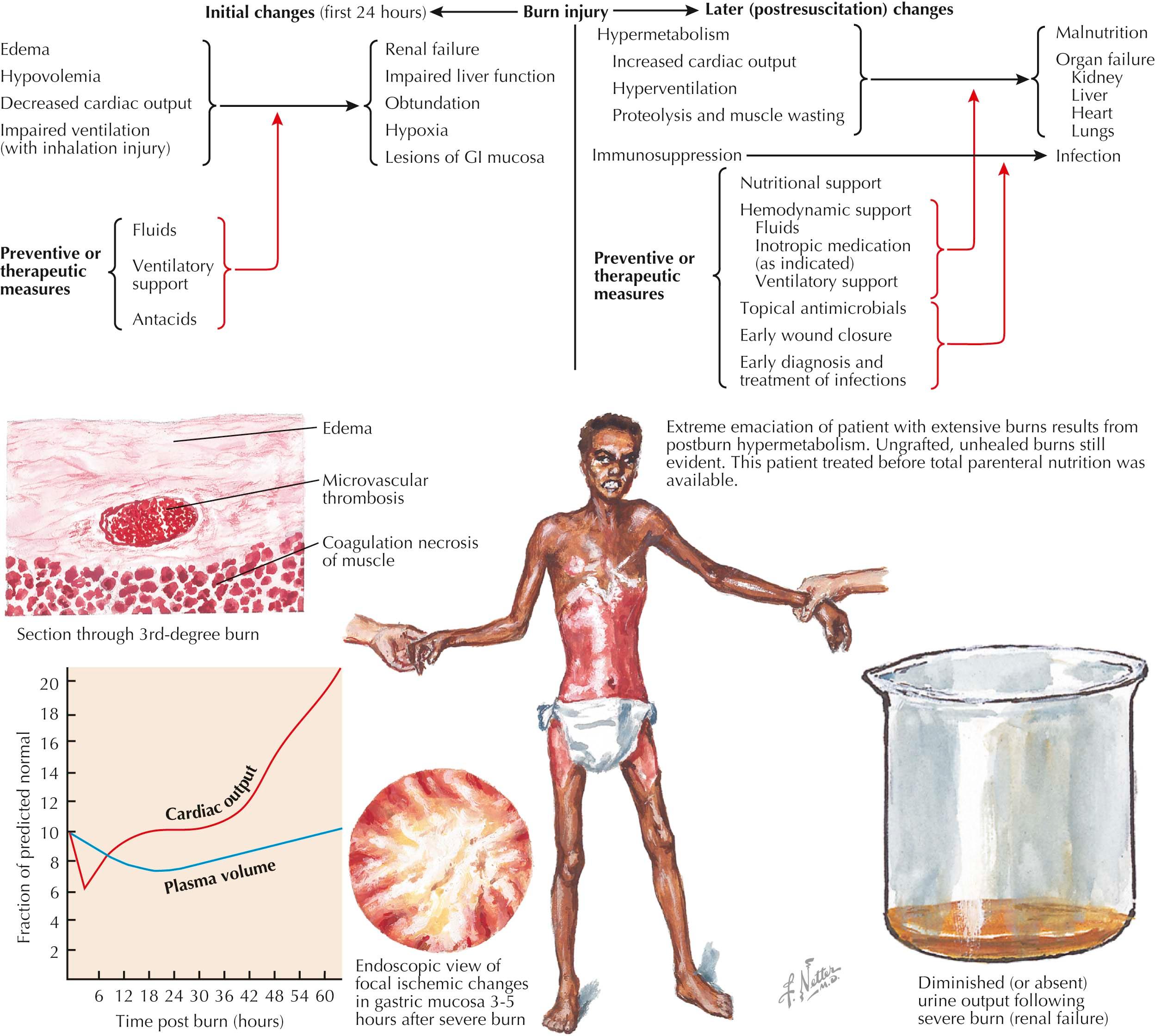
The deleterious effects of burn injuries on every organ system are proportional to the extent of the thermal injury. The prominence and clinical importance of the various systemic effects are time related. Some systemic effects are evident immediately, whereas others develop only after resuscitation or even far into the convalescent period. The initial and later (postresuscitation) changes and appropriate preventative or therapeutic measures are shown on Plate 7-10 . During the first 24 hours, hemodynamic and pulmonary dysfunctions predominate and require therapeutic intervention to minimize complications. During the second 24 hours, functional capillary integrity is restored, plasma volume is reconstituted by continued administration of resuscitation fluid, and cardiac output rises to supranormal levels—the first manifestation of postinjury hypermetabolism. Metabolic and immunologic changes due to the burn injury itself can all be aggravated by superimposed complications, particularly infection and sepsis. Early diagnosis and prompt treatment of infections that do develop minimize the occurrence of sepsis-related kidney, liver, heart, and lung failure. Pulmonary insufficiency due to sepsis predisposes the patient to pneumonia, the most common fatal complication, and may also impair oxygenation of peripheral tissues and increase susceptibility to invasive wound infections. Failure to meet the patient's markedly elevated nutritional needs not only permits erosion of lean body mass but also is associated with delayed healing, impaired take of skin grafts, exaggeration of immunologic deficits, increased risk of infection, and delayed convalescence. Maintaining pulmonary and cardiac functions to provide adequate tissue blood flow and oxygenation ameliorates the incidence and severity of the complications of these late metabolic and immunologic changes, thereby optimizing the resistance of the burn wound and other tissues to infection. Total metabolic support entails maintenance of fluid balance, mechanical ventilatory support, use of topical antimicrobial creams, nutritional support, and early wound closure.
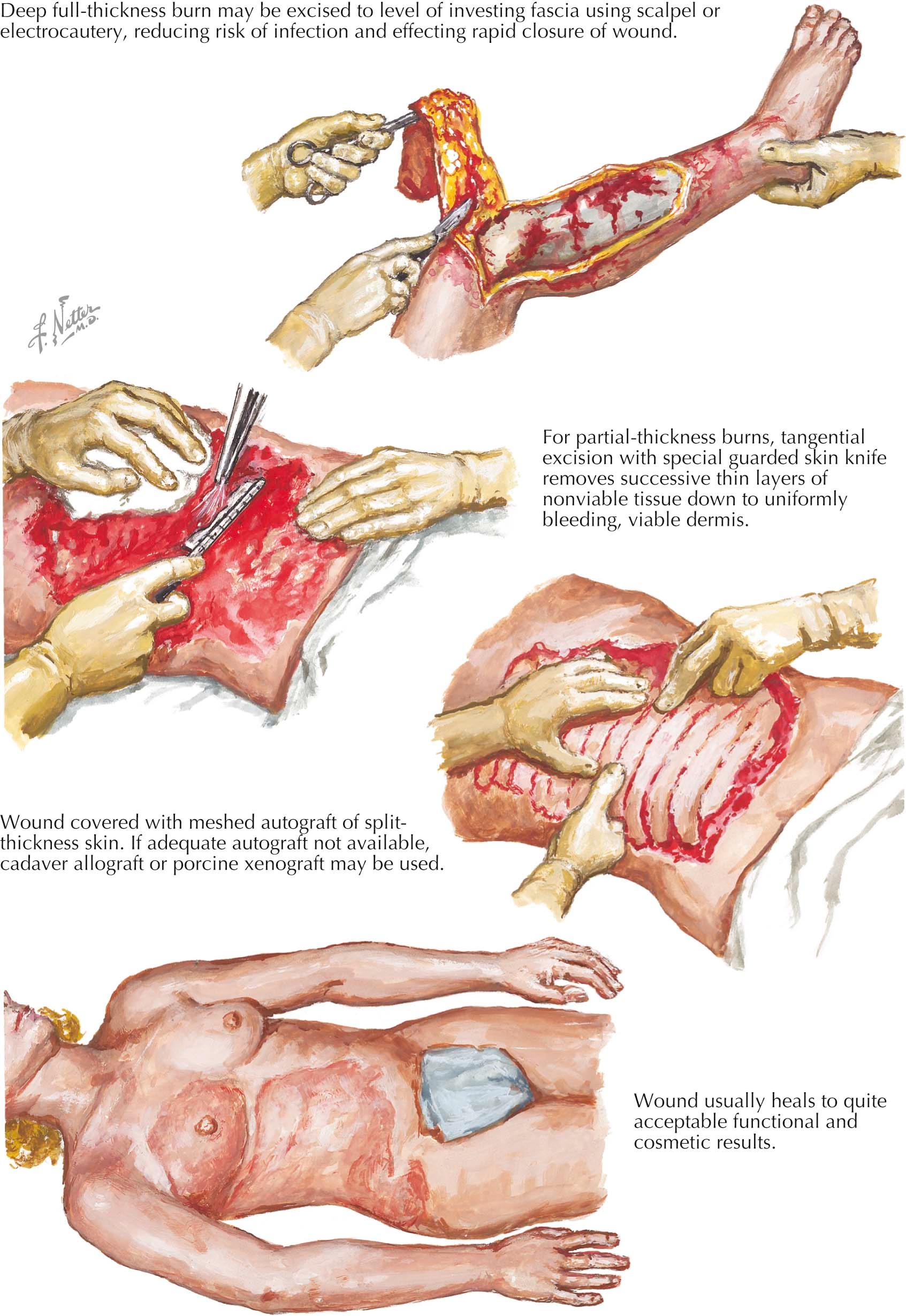
Surgical excision of burn wounds should be performed as soon after resuscitation as the patient's hemodynamics and pulmonary status permit (see Plate 7-11 ). Surgical removal of the necrotic tissue contributes to minimizing the risk of infection and the degree and duration of physiologic stress.
Deep, unequivocally full-thickness burns may be excised to the level of the investing fascia using a scalpel, an electrocautery device, or even a laser. The excised wound must be covered with a skin graft to prevent desiccation of the exposed tissue and to effect definitive closure.
Tangential excision is commonly employed in the treatment of partial-thickness burns. Successive thin layers of nonviable tissue are removed until a wound bed of viable tissue, characterized by uniformly dense capillary bleeding, is developed. If the full thickness of the skin is involved, the excision should extend until normal fatty tissue is encountered. The wound is closed with a split-thickness skin graft. Blood loss associated with tangential excision, which can be prodigious, can be minimized by the application of gauzes soaked in a thrombin solution; by subcutaneous injection of ornithine vasopressin; or, if the burn is on a limb, by use of a tourniquet.
In patients with extensive burns but limited donor sites, the use of meshed grafts increases the area of burn wound that can be covered with the skin harvested from a donor site of given size. Although the expansion ratio of meshed grafts can be as great as 9 : 1, such large grafts are associated with a prolonged time of epithelialization of the interstices and increased scarring. Therefore, expansion should be limited to the commonly used ratios of 2 : 1 or 3 : 1. When donor sites are inadequate because of extensive burns, any of several synthetic or biologic dressings can be used for temporary coverage of the wound. Viable cutaneous allograft is the gold standard of biologic dressings and when obtained through reputable sources such as the American Association of Tissue Banks the risk of disease transmission has been decreased significantly. Cutaneous xenografts (commonly porcine) are alternatives to cadaver allografts, and synthetic products such as Biobrane, a silicone membrane on nylon fabric coated with dermal porcine collagen, and Transcyte, which is Biobrane and cultured newborn human fibroblasts, may also be used for temporary wound coverage.
The benefits of burn wound excision are realized at specific physiologic costs: blood loss, pulmonary effects of anesthesia and surgery, and sacrifice of any partial-thickness burn within the area of a full-thickness burn. Along with physiologic fluid resuscitation, improved ventilatory support, and effective control of infection, excision has greatly helped survival in burn patients. Improvements in functional and cosmetic therapies further facilitate rehabilitation of patients.
Become a Clinical Tree membership for Full access and enjoy Unlimited articles
If you are a member. Log in here